Itinerary to See Sofia in One Day
What is the best Sofia Itinerary? To see all the sights in Sofia, Bulgaria, in one day just follow our simple self-guided walk through this amazingly historical European city.
If you’re visiting Bulgaria’s capital for only one day that’s fine, you can easily see the main places of interest in the historic old town. However, a Sofia 2 days itinerary (or a long weekend in Sofia) gives you time to enjoy all the cultural and leisure activities on offer as well. Better still, travel over to neighbouring Turkey and combine your trip to Sofia with a beach holiday in Marmaris on the turquoise coast.
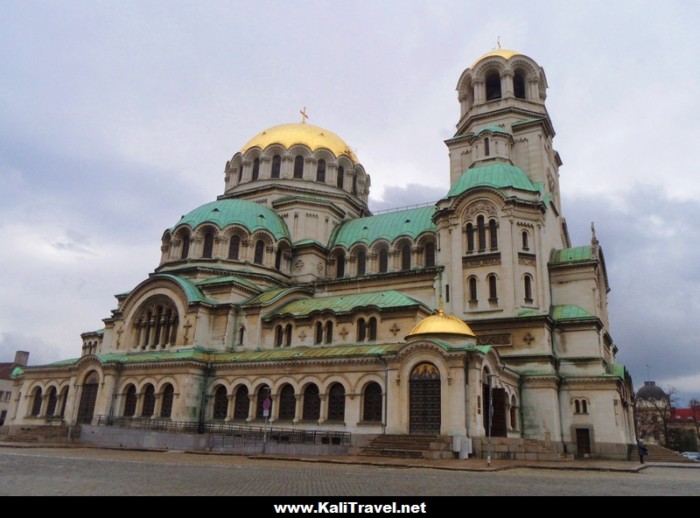
Sofia Historical City Centre
Originally founded by Serdi Tribes in the 7th millennium BC, Sofia has been ruled in turn by the Roman, Byzantine, Ottoman and Soviet Empires. Centuries of religious and cultural diversity are evident in the cityscape today. Stroll around the historical centre to discover the principal sites, streets lined with magnificent buildings where royalty and the affluent lived, see cathedrals, churches, the synagogue and mosque, or the monuments to past battles presiding over peaceful city parks.
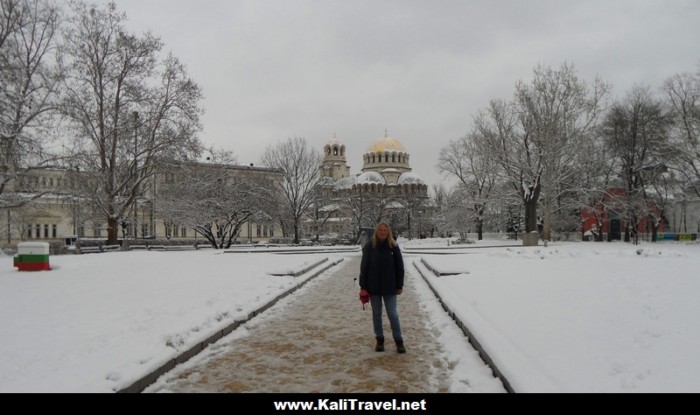
Sofia Itinerary – Top Attractions to Visit
- Eagles’ Bridge to Sofia University
- Saint Alexander Nevski Cathedral
- St Sofia Church
- National Opera and Ballet
- National Art Gallery
- Ivan Vazov National Theatre
- St George Rotunda Church
- St Petka of the Saddlers
- Saint Kyriaki Cathedral
- Cathedral of St Joseph
- Sofia Synagogue
- Banya Bashi Mosque
- Central Mineral Baths – Sofia History Museum
- Shopping in Sofia: Central Market Hall, Vitosha Boulevard, Graf Street
- Knyazheska Garden, Lake Ariana & Borisova Gradina Garden
Sofia really is worth visiting, it’s easy and safe to walk around the old quarters, discovering the top attractions at your own pace. Locals may seem reserved at first but the truth is, although the majority of Bulgarians do not speak English, they are generally most helpful and polite. If you need directions or any information try asking a younger person or use a multilingual phone app. Walking tours are an interesting experience and timesaving if you’re only here for one day – meet up with a friendly guide who’ll show you around on an organized itinerary, explaining past events to give a true insight into the heritage Sofia is famous for.
Sofia is a great city break and pretty cheap moneywise compared to other European capitals. Whether that’s a performance at the theatre or opera, a visit to an art gallery or museum, shopping at the malls and markets, dining in a good restaurant, or trying some Bulgarian wine or beer, there are so many things to do in Sofia in one day. It’s one of the best places to visit in Europe.
What to See in Sofia in One Day
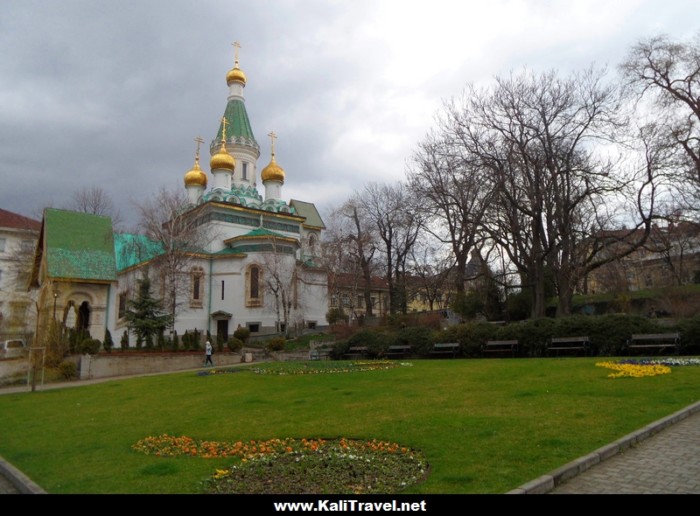
Eagles’ Bridge
Eagles’ Bridge (1891) is a good place to start a walking itinerary through downtown Sofia. Four bronze eagles on stone columns watch over Orlov Most, a busy junction with a handy pedestrian underpass to sidestep the traffic. Many of these subterranean crossings are like bazaars with kiosks full of woolly hats, brollies, and all kinds of knick-knacks at budget prices, as well as cafes and fast food eateries.
Orlov Most Square. Getting here: Sofia University Metro Station on Line 1.
Eagles’ Bridge to Sofia University
From Eagle’s Bridge walk north along Tsar Osvoboditel Boulevard for 5 minutes, keeping Knyazheska Garden to the left. Sofia Tourist Information Office is located underground in the St Kliment Ohridski Metro underpass near Sofia University, and a handy place to stop off for a map of Sofia.
Tsar Osvoboditel Blvd, 22. Open weekdays 9.30-18.00. Email: tourist@info-sofia.bg
Sofia University
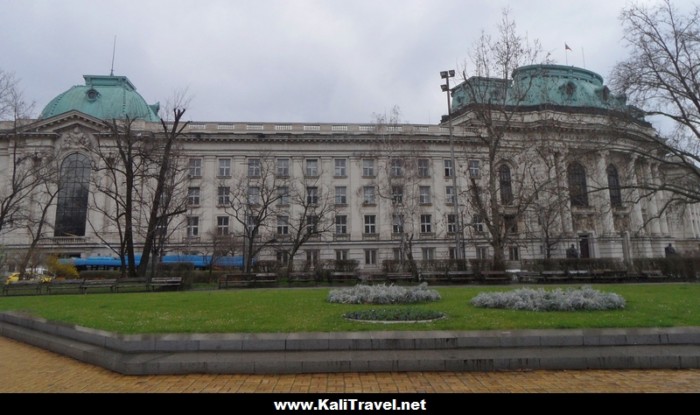
Sofia University is difficult to miss! It’s the massive white building with sculptures on the façade and green roof detail which curves around the large junction. Built over a decade (1924 -1934), the university itself was founded in the previous century in the year 1888.
Tsar Osvoboditel Blvd, 15.
Assembly of the Republic of Bulgaria
The ‘Assembly of the Republic of Bulgaria’ is a two minutes away on Narodno Sabranie Square, in the vicinity of Sofia’s cathedral. This stately building (1884) is the country’s main parliament and visitors are welcome to attend open plenary sittings – ask for permission in advance or join a group tour.
Narodno Sabranie Square. Open weekdays.
Saint Alexander Nevski Cathedral
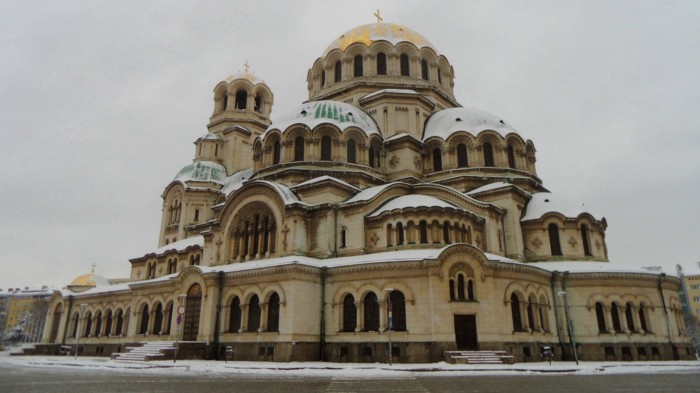
St Alexander Nevski is the grandest Orthodox Christian Cathedral in Bulgaria and Sofia’s most photographed sight. Dating to 1882, the opulent design mimics the Byzantine architecture of the Middle Ages -a huge golden dome and adjacent belfry are encircled by an array of green onion domes which enclose the extraordinary Basilica. Step inside to admire the lavish decoration of Venetian marbled halls and gilded religious icons which shelter the tomb of the illustrious saint. An important collection of Christian art is on permanent display in the crypt.*
Alexander Nevsky Square. Open every day 7.00-19.00; Free entrance to the cathedral.
*The Museum of Christian Art is run by the National Art Gallery, see this section for times and prices.
St Sofia Church
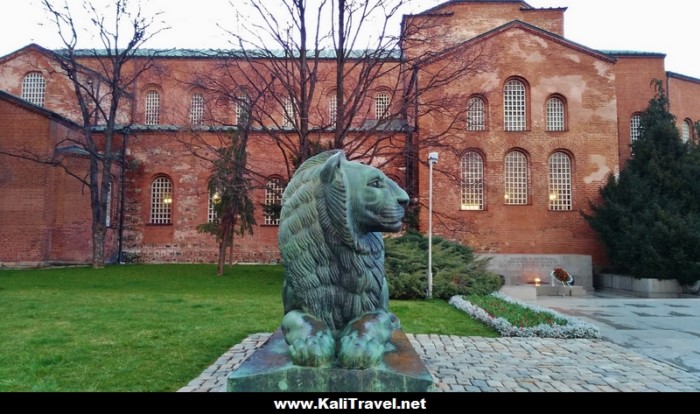
St Sofia Church was founded in the 4th century over the remains of an ancestral burial site. Although the wooden structure was lost, remnants of the foundation stones are still visible today. This is the oldest church in Sofia, the one the city is named after! Even though the building has been reconstructed over the ages, most of the architectural design is original 6th century. A total contrast to the fairytale cathedral, this plain brick-clad sanctuary symbolizes peace not prosperity. A sculpture of the ‘Bulgarian lion’ sits on the lawn opposite the national ‘Monument to the Unknown Soldier’, a single burning flame and memorial plaque against the church façade.
Paris Street, 2. Open every day March to September 7.00-19.00; October to February 7.00-18.00.
Free entrance to the church; Necropolis Museum costs 6 lev.
National Opera and Ballet
Sofianites traditionally enjoy classical literature and music, theatre and ballet performances, and this appreciation of culture and art continues today. The Bulgarian National Opera and Ballet House was inaugurated in 1953, some sixty years after the country’s first opera and drama society formed back in 1890. The building itself is a work of art, an impressive white stone colonnaded structure resembling an ancient Greek temple. See the National Opera and Ballet website in English for full information on this year’s programme and book your ticket for a genuinely memorable evening out. Meanwhile at home, watch the live streaming of selected performances.
30 Dondukov Blvd.
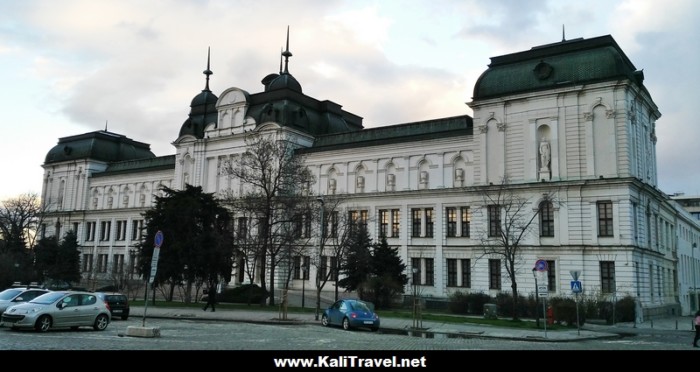
National Art Gallery
Bulgaria’s National Art Gallery is located in the Royal Palace on ‘Battenburg Square’. The intriguing history goes something like this: the Sultans of Turkey lived on this spot in an opulent residence beside a Great Mosque until the decline of the Ottoman Empire and the Bulgarian Monarchy reigned once again. The extravagant Viennese style palace retains the foundation stones and part of the original frontage, the rest being totally reformed for the new Tsar and his entourage (1880), and soon after extended into the extraordinary two winged building you can see today. Home of the National Art Gallery and Ethnographic Museum since 1953, an important collection of medieval paintings and contemporary Bulgarian art are on permanent exhibition.
Alexander 1 Square. National Gallery website in English.
Open Tuesday to Sunday 10.00-18.00; closed on Mondays, Bulgarian holidays, Orthodox Easter, Christmas Day and New Year’s Day. Tickets cost 6 lev; students & pensioners 3 lev; Thursdays reduced rate of 2 lev.
Sofia City Garden
Sofia’s oldest park, City Garden was created in 1872 opposite the Royal Palace when Tsar Alexander II ruled Bulgaria. Bordering onto the National Art Gallery and the Ivan Vazov National Theatre, lawns and flowerbeds edge tree-lined paths where old men sit patiently on park benches over a daily game of chess and children play beside the ornamental fountains.
Ivan Vazov National Theatre
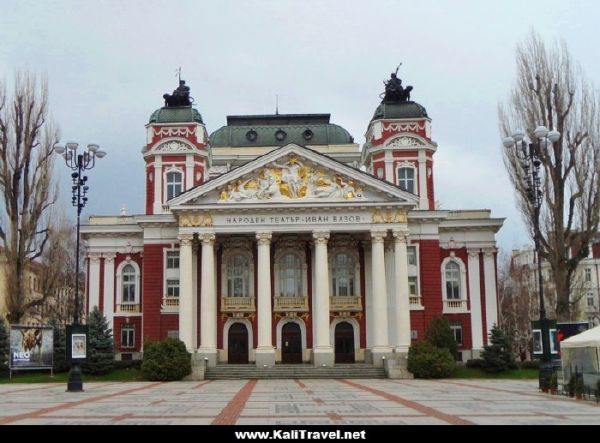
The National Theatre is another of the must-see sights in Sofia. This stunning venue is a true reconstruction of the original which was built in Art Nouveau style in the early 1900’s. The striking symmetrical façade features large white columns, corner towers, numerous statues and elaborate embellishments. The richly decorated main stage is overlooked by two tiers of balconies, there’s a chamber hall, the small Apostol Karamitev stage, and a summer stage for open air performances.
Dyakon Ignatiy Street, 5. National Theatre website in English.
Box office hours: Monday to Friday 9.30-19.30; Saturday and Sunday 11.30-19.30.
St George Rotunda Church
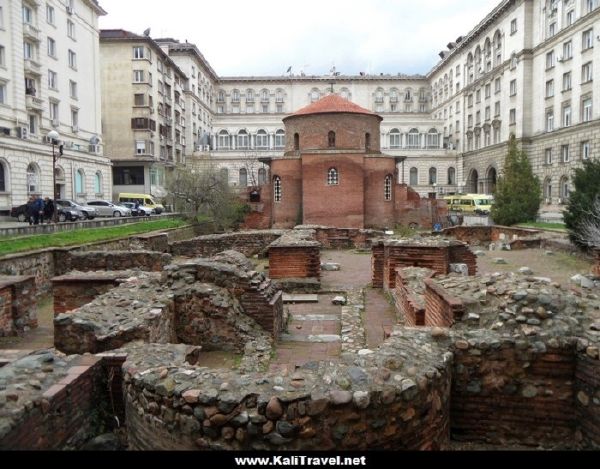
St. George Rotunda is concealed in a sunken plaza wedged between the Presidency and Sheraton hotels. This distinctive little church has a circular design featuring a brickwork central dome and is the oldest building in Sofia, one of Europe’s hidden gems. Erected in the fourth century during the Roman era, this was once the site of a pagan place of worship in the olden city of Serdica, some of whose ruins are still visible in front of the church today. Inside the rotunda the remarkable frescoes on the interior walls date back to different periods in time… floral designs painted by the Romans (4th century), medieval angels (10th century), Christian prophets (11th & 12th centuries) and bishop (14th century), and Islamic motifs (15th century).
Kniaz Aleksandar Dondukov Blvd, 2. Free entrance.
Open every day 8.00-18.00. Tourist visiting hours 11.00-17.00.
St Petka of the Saddlers
St Petka of the Saddlers is a small 11th century church in a surprising location. Once again built over a much older temple, this primitive house of worship is almost buried between modern buildings at the entrance to Serdika Metro station in the heart of downtown Sofia. The simple thick stone and redbrick appearance is deceiving for inside the walls are painted with biblical scenes, the invaluable work of artists from the 14th to 19th centuries.
Tzum underpass, Serdika Metro Station.
Open every day 7.30-19.30. Free entrance.
Saint Kyriaki Cathedral
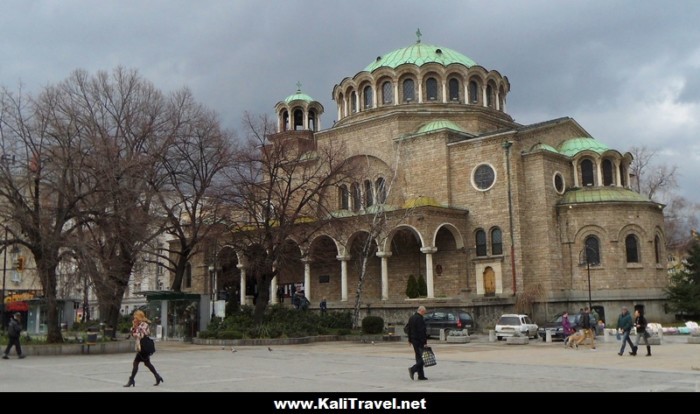
Saint Kyriaki Cathedral is an Orthodox Christian Church in Nedelya Square, (also known as Sveta Nedelya) it’s one of the emblematic sites that Sofia is known for. Originally a small wooden church erected in the 10th century, later rebuilt as a grand Cathedral in 1856, and severely damaged in the 1925 terrorist attack, St Nedelya’s has lived through some dramatic events. Although the ‘new’ temple dates to 1933, it retains that majestic medieval flavour with a huge central dome and bell tower.
Sveta Nedelya Square. Open every day 8.00-18.00.
Cathedral of St Joseph
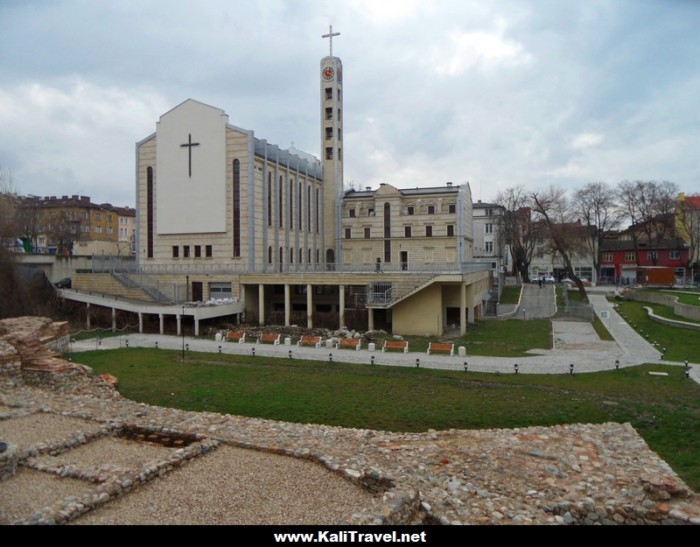
St Joseph’s is a Roman Catholic Cathedral and the design contrasts quite radically to Sofia’s other historical temples, as this is a recent construction (2006) which replaces the religious complex hit by a bomb in World War II. Originally built in 1880, the site included a Capuchin Monastery and school, the choir hall and parish church. The new Cathedral has a rectangular central nave with a tall thin bell tower. A 7 metre high wooden crucifix hangs above the altar watching down on the rather austere interior.
Kniaz Boris I Street, 146. Open every day 7.00-19.00.
Sofia Synagogue
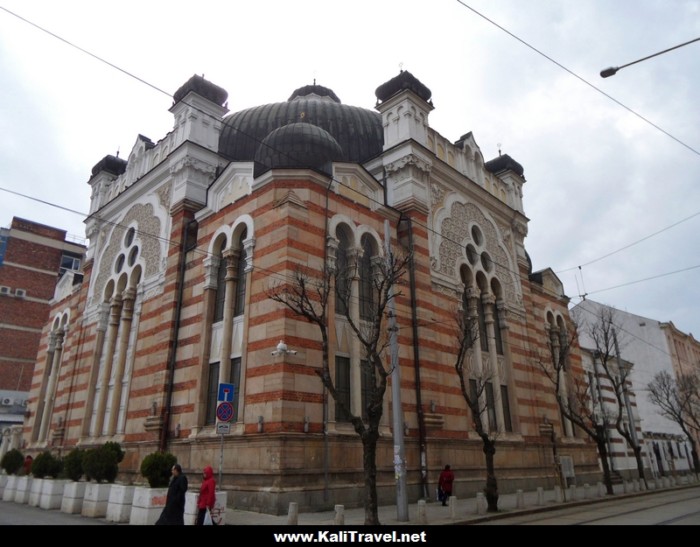
Sofia Synagogue (1909) is the biggest Sephardic temple in Europe. The building’s red and white brick design is enhanced with Venetian-style detail on the main façade. The 8-sided central dome is a distinguishing architectural element. Inside the Italian theme continues with marble columns and rich mosaics. The immense golden chandelier and a Jewish History Museum are of particular interest.
Exarch Joseph Street, 18. Tourist visits Monday to Friday 10.00-16.00. Entrance costs 5 lev.
Banya Bashi Mosque
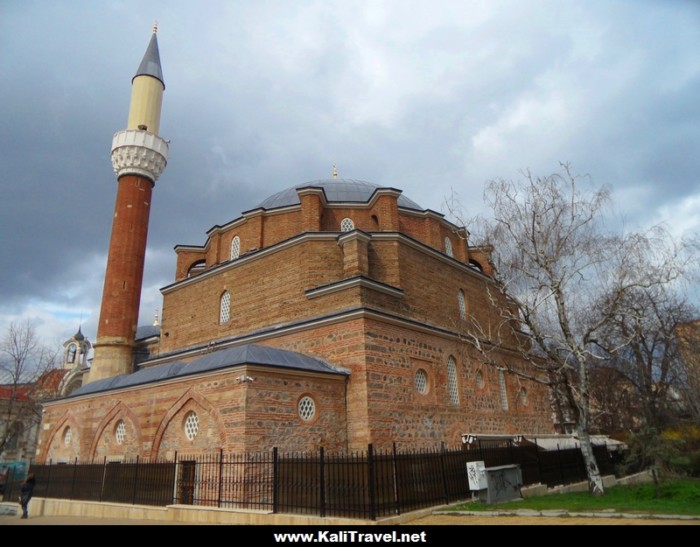
Banya Bashi Mosque (1566) is built over steamy underground hot springs and the name implies ‘many baths’. Similarly designed to Sofia’s Orthodox churches in redbrick with a large central dome, a thin tall minaret is the distinctive feature. The red carpeted mosque is decorated inside with exquisite turquoise ceramic tiles and scripts from the Quran. Non-Muslims are welcome to enter when prayers aren’t being held, but remember to dress modestly and take your shoes off (women should cover their hair with a headscarf).
Knyaginya Maria Luiza Blvd, 18. Open every day 5.00-20.00. Free entrance.
Sofia ‘city of religious tolerance’
Known as the city of religious tolerance, citizens of four faiths -Roman Catholics, Orthodox Christians, Jews and Muslims- live together in harmony in Sofia as they have done for centuries. Unfortunately, many historical temples have disappeared over the ages, some were destroyed, many rebuilt, others converted for a different use.
Banski Square
Banski Square lays between Banya Bashi Mosque and Central Mineral Baths where the ancient ruins of a bathhouse can still be seen; a small park with an ornamental fountain and hot springs, this one of the favourite places where locals come to fill bottles with natural drinking water.
Central Mineral Baths – Sofia History Museum
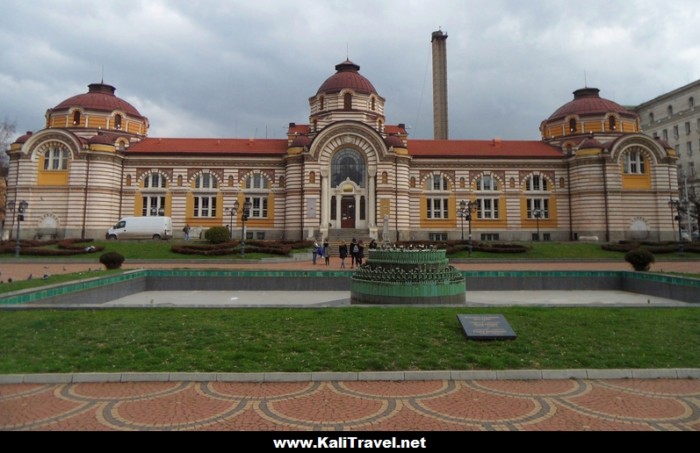
Although Sofia has been known for its hot springs since antiquity, there aren’t any public spas open in the city today. Ancient Roman Baths and a subsequent Turkish Haman once occupied this site. The famous Central Mineral Baths opened in 1906 but lost popularity over the years, eventually closing in 1986. After massive restoration, the distinctive yellow, white and red brick-faced premises reopened in 2015 as Sofia History Museum, where permanent and temporary exhibitions are on now display.
Banski Square. History Museum website in English.
Open every day May to October 10.00-18.00; closed Mondays November to April. Entrance 6 lev.
Shopping in Sofia
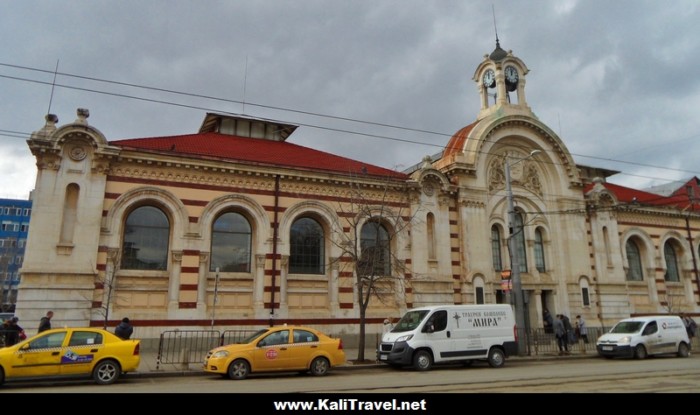
Central Market Hall
Central Market Hall is on the block between Sofia Synagogue and the Mosque, in the Square of Religious Tolerance. This 3-storey rectangular covered market has the familiar red and white brick striped façade and a small clock tower over the front entrance. Open since 1911, it was remodeled in 1988 keeping the original appearance. Buy some fruit at the market –there’s all the fresh produce you need if you’re staying in an apartment-, grab something to eat at a food stall, or just peruse the assorted small shops.
Knyaginya Maria Luiza, 25. Open every day 7.30-20.00.
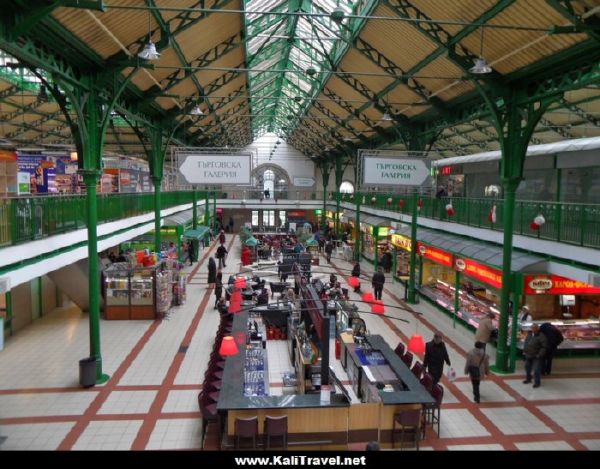
A five minute walk down Maria Luiza Blvd back towards Sveta Nedelya Square brings you out right beside Sofia’s fashionable zone!
Vitosha Boulevard
Vitosha Boulevard is the place to stop for lunch. The kilometre long pedestrian paved section of this long yellow paved avenue starts by St. Nedelya church. ‘Vitoshka’ is a trendy area of Sofia with an array of gift shops, boutiques, restaurants, cafes and ice-cream parlours, a favourite with Sofianites and tourists alike. In the side roads off the main stretch there are international clothes stores, a ‘big M’ and some smart eateries. Just over 2 kilometres from Eagle’s Bridge, this district is a mere 30 minute walk from our starting point! However, at a leisurely pace with all the detours to see monuments and places of interest, this interesting itinerary can easily take all morning! Gradually stroll back over the afternoon through the commercial district to see another side of Sofia historic centre.
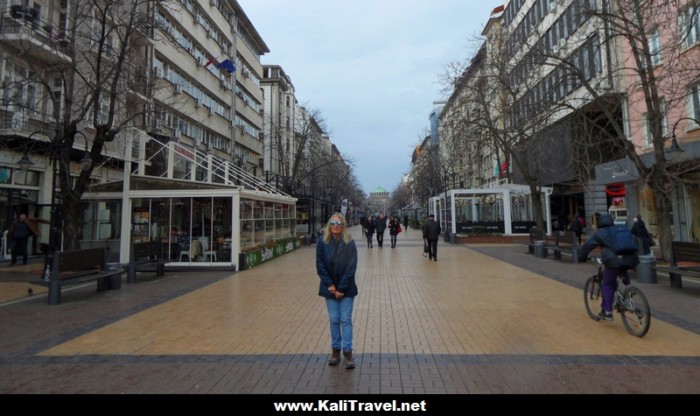
Graf Ignatiev Street
‘Graf’ is five minutes away, a busy shopping street lined with unpretentious stores where there’s everything on sale from shoes to pastries. Stop to browse the book stalls on Slaveykov Square or the outdoor fruit, flowers and vegetable market. This is a pedestrian area but beware of passing trams!
Normal shopping hours in Sofia are 9.30-19.30 Mondays to Saturdays, shopping malls 10.00-22.00.
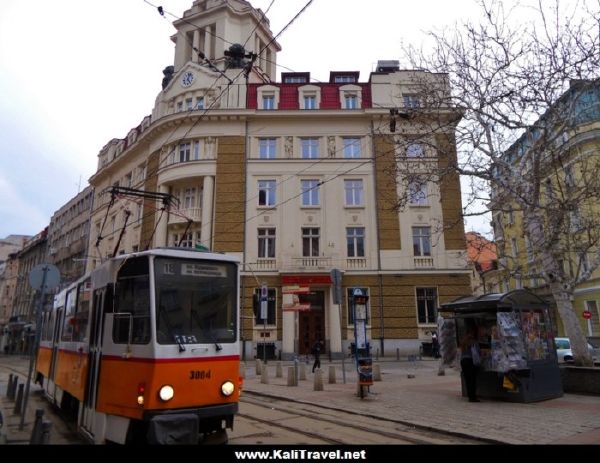
Shishman Street
Follow Shishman Street back towards the Bulgarian Parliament to find Sofia’s arts and crafts neighbourhood. Linger awhile admiring the local art galleries then stop off at a chic wine bar or coffee shop along the way!
Knyazheska Garden
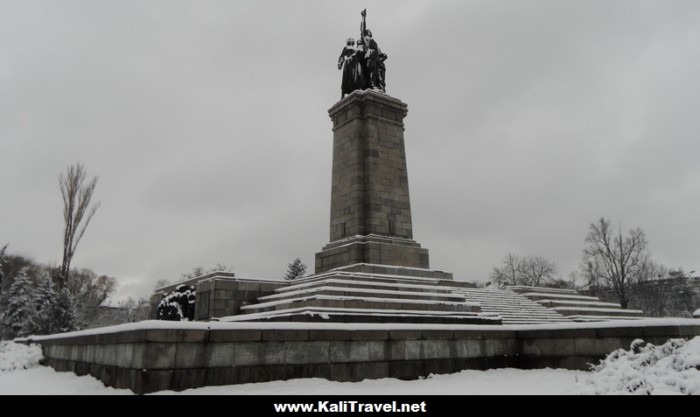
It’s a short walk to Knyazheska Garden where the Monument to the Soviet Army – bronze statues of a Russian liberation soldier holding a gun and a Bulgarian couple with their baby- is a somewhat controversial memorial to the past.
Lake Ariana
Lake Ariana is the large leisure lake in nearby Boris’s Park, and close to Eagle’s Bridge where our Sofia itinerary began. Used as a skating rink when the waters ice over in winter and for pleasure boats when the sun comes out in warmer weather, it’s a fun here any time of year and a particular favourite with families and youngsters at weekends or holidays.
Borisova Gradina Garden
Borisova Gradina is the parkland that stretches southwards from Eagle’s Bridge. ‘Boris’s Park’ was designed in 1884 and the appearance changes dramatically depending on the seasons…the snow laden trees of winter blossom in the springtime, provide shade in the summer sun and carpet the ground with golden red leaves come autumn. The extensive public gardens include acres of woodland crossed by paved tracks, ornamental shrubs and flowerbeds, and the famed water lily pond. It’s one of the most popular places in Sofia for outdoor activities, for jogging or cycling, and relaxing from city life.
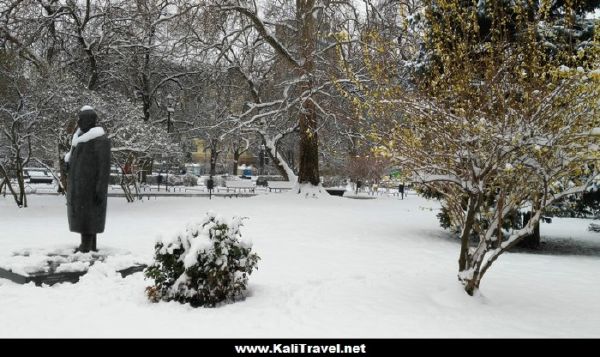
Sofia National Stadium and Bulgarian Army Stadium
The Vasil Levski National Stadium and the Stadium of the Bulgarian Army are both located by Boris’s Park. The complexes have various facilities such as international football grounds, basketball and tennis courts, athletic tracks, and gymnasiums. Major sports competitions and musical events are organised year round, so it’s worth checking dates to see what’s on during your time here.
A stroll around the park and you’re back at Eagles’ Bridge with time to relax before getting ready for an evening in Sofia!
Exciting City Itineraries in Europe
2 Day Venice Itinerary – Best Places to Visit in Italy
Venice is one of the best places to visit in Italy, a unique and thrilling experience! Our 2 day Venice itinerary is totally affordable and the whole trip easy to organize, just follow these simple tips…
Ultimate Granada Guide, Spain – what to see in 3 days
Visiting Spain and only 3 days to see Granada? Here’s our ultimate city guide! Granada is an enchanting city, the ‘old town’ full of plazas & ancient monuments, and Alhambra Palace ‘World Heritage Site’…
1 Day Itinerary of Cordoba (Spain)
Discover Córdoba, the Spanish city with a 1000 ancient archways & a famous Cathedral Mosque. Here’s our rough guide of what to see in 2 days! Córdoba sits beside the River Guadalquivir in the heart of Andalucía…
2 Days sightseeing in Seville (Spain)
2 days in Sevilla, southern Spain. The panoramic view from our terrace is stunning – Seville skyline backlit by the sunset, the unmistakable Giralda tower and a dozen church spires piercing the sky…




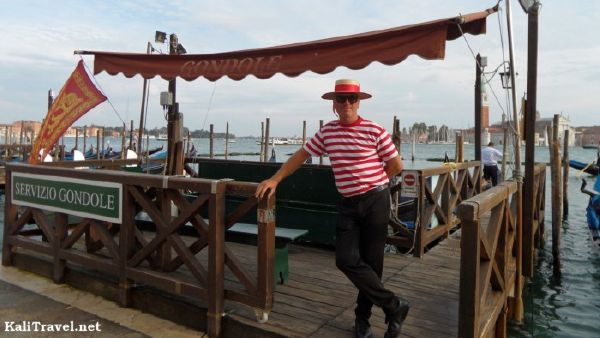
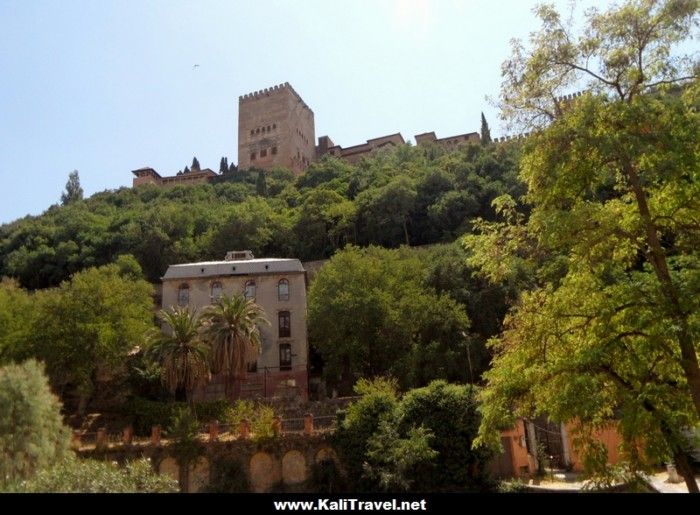
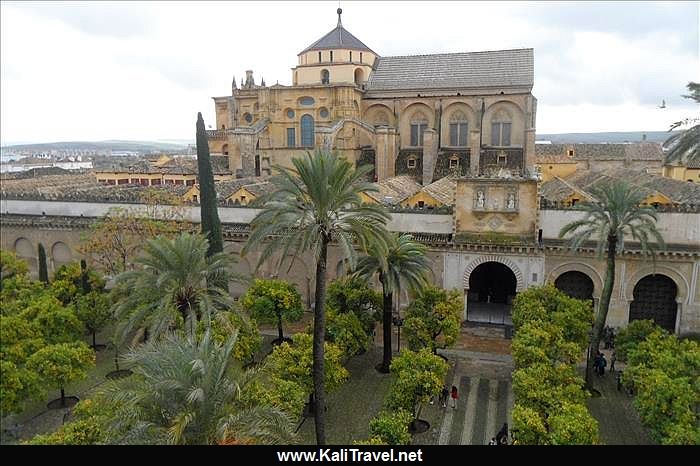
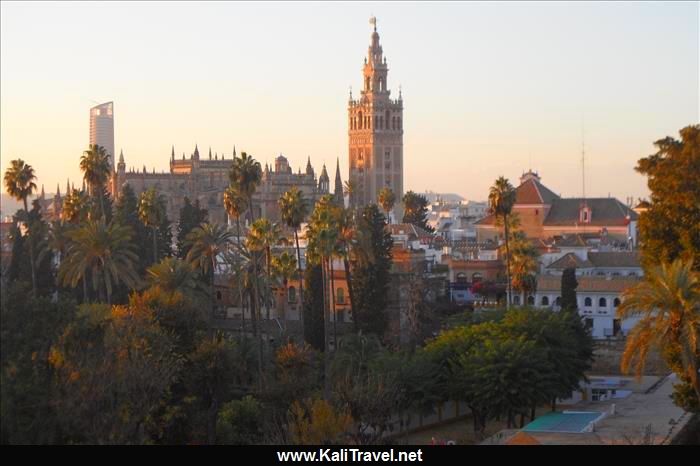
There’s so much to see here. It’s a shame that the baths are no longer open but good to see it has been restored and is now the Sofia History Museum. The architecture is really beautiful.
Sofia is a fascinating city to see and absolutely magical after a snowfall!
Thanks for the tips! I’ve just written all of these places down on a list :)